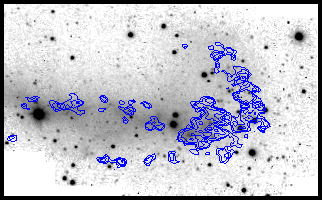
Gaseous Substructure in Tidal Tails and the
Formation of Tidal Dwarf Galaxies
To be submitted to AJ
Go here for more figures on NGC 4038/9
and here for more details on the HI
observations
We use
our recent HI and optical observations of the well known
interacting system NGC 4038/9, "The Antennae",
to explore the nature
of the gaseous substructures found within its extensive tidal tails,
including the putative tidal dwarf galaxy at the end of the southern
tail. We analyze about a dozen HI concentrations within the tails,
finding that they do not distinguish themselves from interclump
regions in terms of their HI linewidths, optical surface brightness,
or optical colors. We do find evidence that one of the star-forming
regions within the tidal dwarf contains enough luminous mass to be
self-gravitating, with a virial mass of 1.1E8 Mo, but this derivation
involves significant uncertainties. The other gaseous concentrations
are either not self-gravitating, or must be bound by non-luminous
matter. We extend other tidal dwarf galaxy candidates reported in the
literature with similar kinematic data. We find that TDG as a class do
not contain enough luminous matter to bind them. Previous work
reached the opposite conclusion by combining luminous mass indicators
and dynamical linewidths in an unphysical manner. Additionally, many
of the TDGs with high inferred luminous-to-dynamical masses are
subject to projection effects, where tidal material piles up along the
line of sight.
Paper: tex file;
ps.gz of text & figs (590 kB)
Figures
